Buying a used bus is a smart investment for many transport businesses. However, without careful inspection, you might face costly repairs later. Whether you’re running shuttle services, school transport, or tour operations, checking the right details upfront can save time and money.
Japanese used buses are popular worldwide for their durability, fuel efficiency, and low maintenance needs. But before sealing the deal, let’s look at the key points every global buyer should inspect.
🔧 1. Engine Condition and Start-Up Behavior
Start by checking the engine’s startup sound, smoke levels, and vibrations. A healthy Japanese diesel engine should start quickly and run smoothly. Excessive black smoke or hard starting could indicate compression issues or injector problems.
If possible, test drive the bus. Listen for unusual noises, observe gear shifting, and check for oil or coolant leaks.
📋 2. Maintenance Records and Service History
A bus with a full maintenance logbook is usually well cared for. These records show:
-
Oil change intervals
-
Part replacements
-
Accident repairs
-
Odometer authenticity
Transparent records add confidence and help forecast future upkeep.
👉 Tip: Use exporters who offer full documentation.
Top 5 Trusted Japanese Used Truck Exporters for Global Buyers
🛠️ 3. Suspension and Undercarriage Inspection
Undercarriage rust, worn suspension, and weak shock absorbers can be expensive to fix. Therefore, it’s important to:
-
Check for rust, especially near joints
-
Inspect springs and bushings
-
Push the vehicle from the corners to test bounce-back
Japanese buses are usually well-built, but coastal exposure may still cause rust, especially in older models.
🚍 4. Tire Wear and Brake Condition
Buses carry heavy loads daily. So, tires and brakes wear fast. Look for:
-
Uneven tire wear (which can signal alignment problems)
-
Visible cracks or bald patches
-
Brake disc thickness and pad life
-
Air brake response (if applicable)
Replacing multiple tires and a brake set can cost more than expected—inspect carefully.
🔋 5. Electrical System and Dashboard Functions
Turn on all dashboard components and make sure they work:
-
A/C
-
Cabin lights
-
Wipers
-
Horn
-
Power windows
-
Gauges and meters
Additionally, check for warning lights or error codes. These may indicate electrical faults or sensor failures.
🪑 6. Interior Condition and Seating Layout
The passenger area tells a lot about how the bus was used. Inspect:
-
Seat frames and cushions
-
Seatbelt condition
-
Flooring for rot or damage
-
Overhead racks, vents, and lighting
You should also consider the seat configuration. Some buyers need more luggage space; others want maximum seating capacity. Choose a layout that matches your operations.
🌐 7. Bus Size, Type, and Purpose Fit
Japanese buses come in many types:
| Type | Capacity | Best For |
|---|---|---|
| Micro Bus | 12–15 | School use, small group transport |
| Mini Bus | 16–25 | Hotel shuttles, local commutes |
| Mid-Size Coach | 26–35 | Employee transport, short tours |
| Full-Size Coach | 36–60 | Intercity, tourism, large groups |
Make sure the bus size meets your daily needs without being too large for roads or parking areas in your region.
🌡️ 8. Cooling and A/C System Performance
Passenger comfort is crucial. Turn on the A/C and let it run for 5–10 minutes. Cold air should flow evenly through all vents. If there’s a weak airflow or strange smells, a system flush or compressor repair may be needed.
📦 9. Luggage Space and Accessibility
For airport and hotel services, undercarriage storage is essential. For school or city use, it might not matter. Check:
-
Luggage space
-
Rear doors or ramp systems
-
Step height and entry width
Japanese buses are often praised for clever interior storage designs, so compare models for the best fit.
📑 10. Legal Documents and Export Readiness
Finally, check if the bus includes:
-
Export certificate
-
Bill of lading (B/L)
-
Frame number matching
-
Odometer certificate (if needed in your country)
A trustworthy exporter should offer photos of documents, bus condition, and engine bay before shipment.
🚚 Conclusion: Inspect Now, Save Later
Buying a Japanese used bus is a smart investment—if you inspect it properly. From engine to interior, every detail matters. With the help of an experienced exporter, you can avoid surprises and get a reliable vehicle that performs well for years.
👉 To start safely, check this trusted list:
Top 5 Trusted Japanese Used Truck Exporters for Global Buyers
